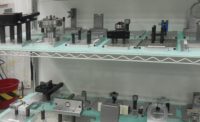What is simulation, exactly? It’s the imitation of a real-world process or system. It uses a model that contains all the assumptions, behaviors, and relationships contained in that system. The model represents the system, the simulation represents the system’s operation over time, and the end result is a proving ground to learn, experiment, and improve that system before making changes in the real world. Simulation offers a venue to not only ask those all-important “what-if” questions about a real-world system, but to investigate and answer them.
TECH TIPS
Five important questions to ask before investing 1. What kind of support is included? It’s good to know qualified individuals will be there when your project needs it most. 2. Is the product actually useable? There are certain simulation solutions that just aren’t easy to use. Anybody who will work with simulation needs to be able to pick it up with minimal effort. 3. Can I customize objects to model my system exactly? An object that models most of what that machine does simply won’t cut it. 4. Is the company continuously updating and developing the product? No simulation product is perfect, so it’s important that the one you choose is constantly being improved. Bonus points to developers who actually listen to and implement your suggestions. 5. Is this 3-D simulation or 2-D simulation? With today’s powerful computers, there are few drawbacks in choosing 3-D simulation. Getting that extra dimension and including aspects like range of motion will only add to the accuracy of the final result. |
Simulation is also not a new idea. The earliest example of a simulation experiment occurred all the way back in 1777 with Buffon’s needle problem, which asked for the probability that a needle dropped on a lined sheet of paper would cross one of the lines. And, like many important concepts that start in the halls of academia, simulation would make its way into industry and government, perhaps most infamously in Stanislaw Ulam’s development of the Teller-Ulam design for thermonuclear weapons. This marked the beginning of computer-based simulation, which sparked innovations such as the General Electric Manufacturing Simulator in the late 1950s and paved the way for the powerful 3-D simulation technology modern businesses enjoy today.
Like any great undertaking, simulation begins with a question. Specifically, it begins with a “what-if” question about your system. Would we be able to recoup our investment if we add a new machine? Why are we getting this bottleneck, and could we get rid of it by speeding up our assembly process? What would happen to our throughput if we changed our staffing schedule? Questions can be concrete or abstract, simple or complex—nearly any question about a system can be tested and answered through an accurate simulation model.
Once the question is established, it’s time to collect data. Data collection doesn’t have to be a grueling experience; most manufacturing facilities probably already have enough information at their disposal to create a solid simulation model. But if you take the time to gather a wealth of accurate data about your system and how it operates, it will pay dividends when you start to comb through the valuable analytics generated from the simulation.
The next step? It’s time to get down to the business of building and customizing the model. The best simulation packages strive to streamline both of these tasks: drag-and-drop controls to easily construct and connect the entities of the system, and simple, intuitive interfaces to customize the logic and operation of each entity. This is where the data you collected will be put to good use. Processing times, arrival rates, conveyor speeds, and any other information relevant to your system and your “what-if” question will be added, and will most likely be altered during a simulation study to test different configurations and scenarios.
The actual simulation of a model can be an uneventful experience, but only because modern computer systems allow large tracts of data to be processed at mind-numbing speeds. Hours, days, weeks, or even months of model time can be simulated in a matter of minutes. This instant wealth of information can then be exported into your favorite spreadsheet program or viewed within an array of charts and graphs to determine what’s going on in the system. The real power of a simulation, though, lies in the ability to make tweaks and experiment. Any good simulation package will contain an experimentation engine to create different scenarios by changing certain variables, run many iterations of these scenarios, and compare the results to find the optimal configuration for the system.
At this point, individuals with any amount of experience in manufacturing can probably foresee the value of simulation in their own facility. Who wouldn’t want the ability to test changes in their system without the risk of experimentation in the real world, especially when the solution plays nice with Lean, Six Sigma, Agile, and other popular process improvement methods? The right simulation tool can serve as the perfect complement to solid operational strategies for companies that are looking for that competitive edge.
How much is a simulation project really worth? That’s a great question. The exact dollar amount will change based on a number of variables, but most manufacturing representatives who have worked with simulation report between 10 and 30% savings. This usually comes in the form of increased throughput, reduced waste, or eliminated bottlenecks in the simulation’s focus area. Sometimes, the most valuable end result isn’t as easy to quantify: reliable, evidence-based validation that the direction a department is heading or an investment being made will eventually pay off.
Feelings of preparation and confidence are normal symptoms of a successful simulation study—and these feelings can be hard to find in the often tumultuous operations of hard-working companies. Once used, it may become clear that simulation should be utilized again in the very near future.
How many companies out there would come to the same conclusion?



